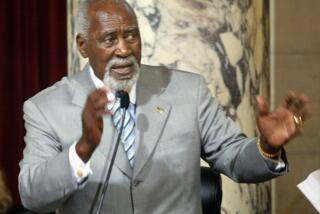VA Chief Logs Frequent Trips to Hometown
WASHINGTON — For Veterans Affairs Secretary Jesse Brown, there really is no place like home.
Brown managed to visit his hometown of Chicago, where he owns an apartment, 20 times in his first 20 months in office--stopping there frequently on the 55 official trips he took outside of Washington, according to government travel expense records.
Many of the visits included weekends or involved lengthy stays with light public schedules. In all, Brown spent 55 weekdays and at least part of 13 weekends in his hometown, fully a third of his time on the road as the nation’s top official on veterans affairs.
His schedule raises questions both about the cost of these visits, which added some expense to Brown’s official travel, and about how he is spending his time on the job. Cabinet heads are in great demand nationwide to tour institutions, speak at public events and meet with groups affected by their agencies, and they must decline scores of invitations for each one accepted.
The exact cost to the government of Brown’s Chicago visits--as well as travel to the Virgin Islands and Hawaii--is not clear because they were often part of longer trips with other destinations. But six trips solely to Chicago resulted in $2,595 in air fare.
Brown’s spokesman said his trips home were justified and that he has not been neglecting veterans’ business in other cities or at the department’s headquarters.
“As a native of Chicago, the secretary is indeed frequently invited to events and activities in his hometown,” spokesman James Holley said. “But it should also be noted that VA has a tremendous presence there,” including a regional office and four hospitals.
Holley called Brown “a dedicated workaholic” who “puts veterans first, every day of his life.” He said that even when Brown’s schedule reflects “personal time . . . in which he may choose to attend to personal matters” when he is in Chicago, the secretary “remains on call and, in fact, conducts departmental business round the clock.”
Nevertheless, no official events were listed on Brown’s schedule for 35 of the weekdays he was in his hometown, according to itineraries and travel documents obtained by The Times under the Freedom of Information Act.
Brown’s only scheduled appearances during a week in the city in June, 1993, were a speech at the Chicago Medical School commencement and three one-hour visits to veterans centers. A year later, the only public activity listed during a five-day visit was an address at the eighth-grade graduation ceremonies at St. Dorothy’s School. Brown’s nephew was among the graduates. An aide flew to Chicago for the graduation speech and subsequent official travel.
Many of Brown’s visits to Chicago were part of longer trips that included other destinations. On occasion, his official itinerary states that “it was monetarily advantageous to the government” for Brown to remain in Chicago rather than return to the capital because of upcoming travel plans.
Aides said that when Brown is in Chicago, he stays in his co-op apartment, where his mother resides permanently. Although he sometimes charged the government for food and other daily expenses, he did not seek reimbursement for lodging.
But the frequent trips resulted in costs to the taxpayers for some of Brown’s air fare, as well as expenses for aides who joined him. During a six-day trip in July, Brown was accompanied by one aide for a night and another for five nights; both traveled at government expense.
Under the law, federal employees must reimburse the government for any personal costs incurred during an official trip. But there is no law preventing senior Administration officials from routing their official travel through places where they also have personal or political interests. Officials are not supposed to plan personal travel and then find a way to turn it into government business, government ethics officials said.
Brown, 50, a combat veteran wounded in the Vietnam War, previously served as executive director of Disabled American Veterans, a 1.3-million member organization. The ex-Marine heads an agency with 265,000 employees and a $37.6-billion budget that provides health care, disability pensions and other social services to many of the nation’s 26 million veterans. His annual salary is $148,400.
The extensive time that Brown spent in Chicago does not appear to parallel that city’s portion of veterans programs, facilities or population.
Only one of the 42 national veterans service organizations is headquartered in Illinois, according to the VA’s directory. No Chicago congressional district ranks in the top third in residents who are veterans.
Yet Brown stopped there three times more often than in Florida, which is home to nine of the 11 leading congressional districts in terms of residents who are veterans.
California and New York each have twice as many VA regional offices and medical centers as Illinois. Yet Brown visited California eight times and New York three times in his first 20 months, compared to the 20 trips to Chicago.
Brown also spent more official time in the Virgin Islands and Honolulu than in New York City, which has 708,000 veterans.
During a four-day official trip to the Virgin Islands last March, Brown’s public schedule was one visit to a veterans clinic, two 30-minute banquet speeches and a half-hour appearance on a radio call-in show. He was accompanied by James Farrell, who handles advance work and logistics, and Patricia Carrington, a benefits expert.
Two months later, during a weekend in Hawaii, Brown toured a VA regional office, attended a potluck luncheon with homeless veterans, delivered a speech and spoke at a reception in his honor. A two-person protective detail was sent out two days in advance, and Brown was accompanied by Farrell and Eric Lindblom, a VA expert on the homeless.
In a typical visit, Brown attended two veterans events in Pittsburgh, Pa., before flying to Chicago on Sept. 8, 1993. During the next two days, his only scheduled event was a visit to a veterans outreach center. On his third day, a Saturday, he attended a black-tie dinner honoring VFW Cmdr. George Cramer. He had no other public events the next two days.
He departed for a National Assn. of State VA Directors convention in North Dakota on Sept. 14 and returned to Washington the following day.
Brown is the second Clinton Cabinet official whose home travel has raised questions.
Former Agriculture Secretary Mike Espy made 20 taxpayer-funded trips to his home state of Mississippi in his first 20 months in office. Espy, who resigned Dec. 31, remains under investigation by independent counsel Donald C. Smaltz for allegations that he abused perquisites, including travel, and accepted sports tickets and other gifts from agribusinesses.
High-ranking officials in previous administrations have gotten into difficulty over official travel with possible personal connections.
Former FBI Director William S. Sessions was criticized for taking 126 trips on FBI planes on which he was accompanied by his wife, including annual taxpayer-funded Christmastime flights to San Francisco, where the couple’s daughter lived. Clinton fired Sessions in 1993 after a Justice Department investigation found that the FBI director had abused his office.
Brown is not the only current member of Clinton’s Cabinet who goes home occasionally. But others have done so less frequently and for shorter durations.
Atty. Gen. Janet Reno paid her own way for four of her 11 official trips to Florida during her first 18 months, including $393 for a one-day trip to Orlando in June, 1993, to address two bar associations, travel records show. Reno, who has generally eschewed costly FBI planes available to her, pays for flights to Miami, her hometown, or any surrounding cities “to avoid even the appearance of impropriety,” said spokeswoman Caroline Adelman.
Times researchers Murielle Gamache, Gary Feld and D’Jamila Salem contributed to this story.
More to Read
Sign up for The Wild
We’ll help you find the best places to hike, bike and run, as well as the perfect silent spots for meditation and yoga.
You may occasionally receive promotional content from the Los Angeles Times.






